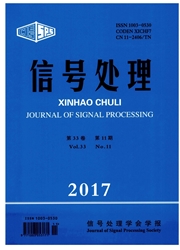

 中文摘要:
中文摘要:
在城市密集环境下,由于局部密集多径反射信号不再符合点目标模型,传统多径参数(波达方向与相对时延)联合估计算法往往失效。针对此类问题本文考虑一种基于空时相干分布的多径模型,并在得到信道估计后将其转化至频率域去卷积获得空时联合信号子空间,由于多径扩展影响该信号子空间不再具有旋转不变结构,本文通过在联合信号子空间中抽取行向量构造不同的矩阵对,使各矩阵对在相位上满足旋转不变性质,然后,利用ESPRIT算法估计中心时延与中心DOA参数。与点目标ESPRIT方法相比该方法能够有效克服多径扩展影响,实现参数自动配对,且具有不敏感于多径分布形式的优点,仿真实验证明了其有效性。
 英文摘要:
英文摘要:
Under dense urban fading environments, muhipath signals do not match the point assumption,performance of traditional muhipath parameters (DOA and time delay) estimation algorithm degrades seriously. For this joint estimation problem a space-time coherent multipath model is considered in this paper. After channel estimation is obtained, it was transformed into frequency domain, a deconvolution process is performed to get the joint signal subspace. Due to the influence of muhipath dispersion it has not the rotational invariance structure any more. In this paper matrix pairs is taken out of joint signal subspace through extracting different rows, and they obey the rotational invariance property in phases. At last centre DOAs and centre time delays are estimated through ESPRIT method. Comparing with traditional point-based ESPRIT the method we proposed here can restrain muhipath dispersion and space-time parameters are paired automatically. Finally simulations show its correctness
 同期刊论文项目
同期刊论文项目
 同项目期刊论文
同项目期刊论文
 期刊信息
期刊信息
